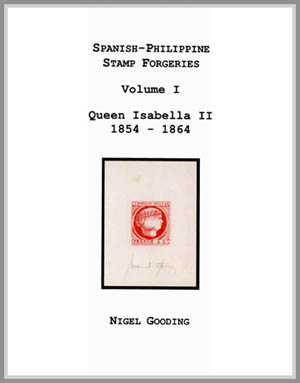|
|
|
|
|
|
|
|
|
|
|
|
|
|
|
|

As the popularity of philately started to take hold in the 1860s, it was almost immediate that forgeries for collectors appeared. Initially, forgeries were sold as innocent imitations, produced to fill spaces for scarce stamps that were often missing from collections due to shortage in supply. It was not long before this turned into fraud as resales and trades were carried out with the forgeries misrepresented as genuine stamps. This was seen by most philatelists as a serious threat to the hobby. The first postage stamps for the Philippine Islands were issued on February 1, 1854, during the reign of Queen Isabella II of Spain. Up to the time when Queen Isabella was forced into exile in 1868, a total of 22 official postage stamps were produced. Sadly, no stamp escaped the hands of the forgers, with each issue possessing copies of forged stamps. One of the earliest accounts relating to forged Philippine stamps is from an article by Don Antonio Gutierrez y Pavia, Postmaster-General of the Philippines from the beginning of 1854, stating: "The only other difficulty that disturbed the harmony and regularity of the new service, was the discovery of two or three forged postage stamps in circulation, which led to the arrest of the criminal, an Indian, who had engraved them in so rough a manner that, in consideration of the ignorance of the culprit, the examining magistrate set him at liberty, without further punishment than the detention he had undergone during the investigation of the case." The primary aim of this handbook is to provide a guide to assist philatelists, across all levels, in ascertaining authenticity of genuine issues. It also provides a listing of known examples to fellow collectors who find forgeries fascinating in their own rights. At the time of print, a total of 82 forgeries are documented, and fortunately, with the odd exception, these are supported with pictures. Most of the forgeries are from unknown forgers, and are assumed to have been issued in the late 19th and early 20th centuries. However, four prominent forgers produced their ‘works of art’ during this period, namely: Jean de Sperati, Englehardt Fohl, Oswald Shröder, and Miguel Segui. A brief account of each of their lives has been included in the handbook. The numbering
system adopted extends from a handbook I wrote in 1995, (Spanish Philippines
– A Handbook of Stamps Issued Under the Spanish Colony of the Philippine
Islands). The numbering system here-in supercedes that used in the 1995
handbook. Since that publication, I have been fortunate to have come across
a large number of previously unrecorded forgeries, and with the assistance
and contributions from fellow collectors, the number has grown quite significantly.
Without doubt, there are bound to be other forgeries, possibly lying dormant
in collections, just waiting to be discovered.
Nigel Gooding |
![]()
|
|